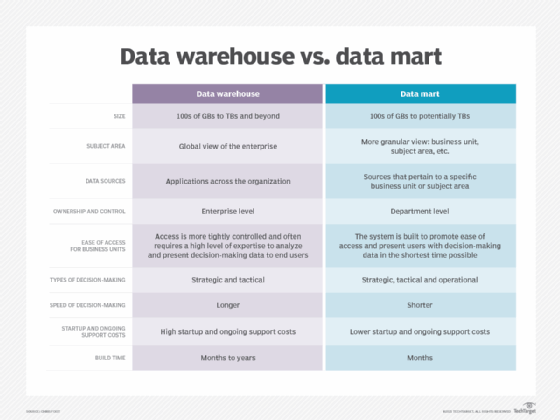michelangelus - Fotolia
The differences between a data warehouse vs. data mart
Data marts and data warehouses are both important in the decision-making process. Here are the biggest differences between the two repositories and why they each matter.
During the early stages of my IT career, there was no concept of organizational data sharing or an understanding of data's global value to the enterprise. IT shops designed and administered applications that focused on day-to-day business operations. Although there were reports and applications to facilitate decision-making, data was only offloaded separate environments when queries began to negatively impact the performance of our operational systems.
As reporting systems matured and their popularity skyrocketed among business units, enterprises realized the real value of the data they collected was its ability to facilitate operational, tactical and strategic decision-making. Once IT shops realized disparate departmental data stores were strategic enterprise assets that would provide intrinsic benefits at an organizational level, they began to collect and combine their information and store it in data warehouses -- and eventually data marts.
Both data warehouses and data marts are special-purpose platforms designed to ingest, store and facilitate the processing of large amounts of information. The primary difference is that data warehouses are centralized repositories that store data from multiple business lines and subject areas. In their purest form, data warehouses facilitate decision-making at an enterprise level.
The challenge with attempting to define and compare a data warehouse vs. data mart is the criteria used to categorize them can be somewhat fluid. There are departmental systems that contain information from different sources and store large volumes of data. Although they may meet the data mart criteria of providing decision-making information to a specific department, the sheer size and the level of detail could also categorize them as data warehouses.
Data warehouses
The goal of a data warehouse is to provide a central repository of data that facilitates informed and insightful decisions at an enterprise level. From C-level executives to operational business units, data warehouses serve a wide and varied user base.
Virtually any data the organization stores could potentially be ingested into a data warehouse. Data warehouse specialists often perform a high level of analysis to identify and evaluate potential input sources.
A key benefit of data warehouses is their ability to provide a global view of customers, suppliers, service providers and business partners that have relationships spanning multiple lines of business.
Data marts
The primary use case of a data mart is to meet the needs of users requiring access to a more granular subject area. The goal of a data mart is to provide those users with fast access to the data that is most relevant to their needs.
A good example would be an organization's sales department. The department manager needs access to products, clients and sales team performance metrics. The amount of time it would take to access and analyze data from an enterprise data warehouse would be longer and less efficient than accessing a repository purposely designed to meet the unit's specific business needs.
In addition to a more focused audience and usage intent, data marts often differ from data warehouses in the type of data they store. Data marts usually contain summary data to accelerate analysis and reporting. The data is purposely customized to meet the specific needs of the target audience. Administrators build additional logical and physical constructs to speed data access performance. They also further refine data to facilitate and accelerate decision-making.
One of the traditional sources for a data mart is a data warehouse. Since data warehouses contain data at an enterprise level, they are excellent sources of information for data marts. But data marts often take feeds from other decision-making data stores and operational systems.
Data warehouse vs. data mart
It's a fairly simple process to determine whether a data warehouse vs. data mart best meets your needs. The chart below will help your decision-making process.

Because of their widespread trade press, most management teams have a basic understanding of data warehouses and the benefits they provide. The biggest challenges for IT are to estimate and justify the high startup and ongoing support costs.
Building a data warehouse is often a big budget, multiyear project. In addition to high back-end administration and infrastructure costs, big data specialists continuously identify new input sources from across the enterprise and refine existing data.
If your organization already has a data warehouse, justifying the costs of building and supporting an additional business intelligence data store, such as a data mart, can be challenging. The first question decision-makers usually ask is why you can't just use a data warehouse. Your team needs to describe the differences between the two data stores and educate decision-makers on how a data mart's more granular focus provides additional benefits to meet the target group's unique needs.








